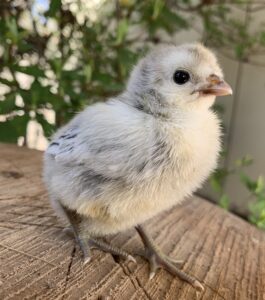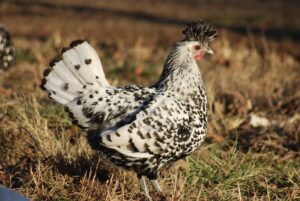Meet the Appenzeller Spitzhauben Chicken
Hey there, chicken enthusiasts! Ready to dive into the world of Appenzeller Spitzhauben chickens? These quirky birds have quite the story to tell, and we’re here to guide you through it all. Get ready for a fun and informative journey into the world of these feathered friends!
Let’s kick things off with a trip down memory lane to the Swiss countryside. Appenzeller Spitzhauben chickens have been strutting their stuff in the rolling hills of Switzerland for centuries. With their fancy plumage and practicality, they’ve earned their place in poultry history.
Egg-cellent Delights: Size, Color, and Production of Appenzeller Spitzhauben Eggs
Size
These beauties come in a range of sizes, from medium to large.
Color
The Appenzeller Spitzhauben hens eggs sport a lovely creamy white shell.
Production per year
When it comes to laying, Appenzeller Spitzhauben chickens are no slouches, churning out around 150 to 180 eggs a year. Talk about a breakfast bonanza!
When do Appenzeller Spitzhauben chickens start laying eggs?
They typically start laying eggs at around 5 to 6 months of age, heralding the beginning of their egg-laying journey.
Appenzeller Spitzhauben Chicken Breed Characteristics
Temperament and Companionship: Appenzeller Spitzhauben Chickens as Pets
Who’s up for some feathered fun? Appenzeller Spitzhauben chickens are not just pretty faces—they’ve got personality for days! With their friendly and lively nature, they’re the perfect companions for chicken lovers of all ages.
Building Trust: Taming Your Appenzeller Spitzhauben Chickens
Ready to make some chicken pals? Taming these quirky birds is all about patience and persistence. Spend time with them, offer treats, and watch as they warm up to you like old friends.
Finding Harmony: Ideal Flock Size for Appenzeller Spitzhauben Chickens
Feathered friends, unite! Wondering how many Appenzeller Spitzhauben chickens you need to start your own flock? Aim for a crew of 4 to 6 birds, and you’ll have a happy, clucking family in no time.
Space to Roam: Providing Adequate Space for Appenzeller Spitzhauben Chickens
Spread those wings and stretch those legs! Appenzeller Spitzhauben chickens love to explore, so make sure they have plenty of room to roam. A cozy coop and a spacious outdoor run are a must for these adventurous birds.
Social Beings: Getting Along with Other Chickens
Time to play nice, feathered friends! Appenzeller Spitzhauben chickens are social creatures who get along famously with other chicken breeds. Introduce them slowly, and watch as they make fast feathered friends.
A Splash of Beauty: The Appearance of Appenzeller Spitzhauben Chickens
Prepare to be dazzled by the fashionistas of the chicken world! With their spangled plumage and jaunty crests, Appenzeller Spitzhauben chickens are a sight to behold. Who knew chickens could be so chic?
Nutritional Needs: Feeding Your Appenzeller Spitzhauben Flock
Feeding Appenzeller Spitzhauben Chicks: Birth to 8 Weeks
- Starter Feed: Picture this: tiny chicks, chirping away and pecking at everything in sight. It’s a busy time, folks! That’s why it’s crucial to start them off on the right foot with some top-notch chick starter feed. Packed with all the good stuff like protein, vitamins, and minerals, this feed gives them the jumpstart they need to grow up big and strong.
- Protein Content: Look for a starter feed with a protein content of around 20% to support the rapid growth and development of Appenzeller Spitzhauben chicks during their early stages. Protein is essential for building strong muscles, feathers, and internal organs.
- Feeding Frequency: Offer starter feed to Appenzeller Spitzhauben chicks ad libitum, meaning it should be available to them at all times. Chicks have small stomachs and high metabolic rates, so frequent access to feed is essential for optimal growth.
- Supplemental Heat: Provide a warm and draft-free environment for Appenzeller Spitzhauben chicks, as maintaining the right temperature is crucial for their health and well-being. Use a heat lamp or brooder to provide supplemental heat, keeping the temperature around 90-95°F (32-35°C) during the first week and gradually reducing it by 5°F (2-3°C) per week until they are fully feathered.
- Fresh Water: Alongside starter feed, provide fresh, clean water to Appenzeller Spitzhauben chicks at all times. Use shallow waterers to prevent accidental drowning, and ensure the water is changed regularly to maintain cleanliness and hygiene.
Transitioning to Grower Feed: 8 Weeks to Point of Lay
- Grower Feed Introduction: Fast forward a few weeks, and those little fuzzballs are starting to look more like real chickens. Time for an upgrade in the food department! Enter grower feed, the next step in their culinary journey. With slightly less protein than chick starter feed, this stuff is tailor-made to support their ongoing growth and development.
- Protein Content: Choose a grower feed with a protein content of around 16% to 18% to support the ongoing growth and development of Appenzeller Spitzhauben chickens as they transition from chicks to pullets.
- Feeding Schedule: Offer grower feed to Appenzeller Spitzhauben chickens in measured quantities, ensuring they have enough feed to satisfy their hunger without overfeeding. Monitor their appetite and adjust the feeding amounts as needed to prevent wastage and promote healthy growth.
- Healthy Treats: Of course, no chicken’s diet is complete without a few tasty treats thrown in for good measure. Fresh fruits, veggies, and the occasional bug or two are all fair game. Just remember, moderation is key! Too many treats can spoil their appetite for the good stuff, so keep it balanced, folks.
Preparing for Egg Production: Point of Lay Onward
- Layer Feed Transition: Now, here’s where things get egg-citing! As Appenzeller Spitzhauben chickens approach the magical age of egg laying, it’s time to switch things up yet again. Say hello to layer feed, specially formulated to give them the nutritional boost they need to crank out those eggs like nobody’s business.
- Calcium Supplementation: But wait, there’s more! You see, laying all those eggs can really take it out of a chicken. That’s why it’s essential to toss some calcium supplements into the mix. Crushed oyster shells or limestone grit are the name of the game here, folks. Just sprinkle a bit in their feed, and they’ll be laying eggs with shells as strong as a Swiss bank vault!
- Feeding Routine: Continue offering layer feed and supplemental calcium to Appenzeller Spitzhauben hens on a regular schedule, ensuring they have access to fresh water at all times. Monitor their egg production and adjust feed quantities as needed to support optimal laying performance.
So there you have it, folks! Feeding Appenzeller Spitzhauben chickens is all about giving them the right fuel at the right time. With a well-balanced diet and a few tasty treats thrown in for good measure, these feathered friends will be clucking contentedly and laying eggs like nobody’s business. Bon appétit, chickens!
Strengths and Weaknesses: Navigating the Traits of Appenzeller Spitzhauben Chickens
Every chicken has its quirks, right? Appenzeller Spitzhauben chickens are no exception. From their beauty and friendliness to the occasional flighty behavior, we’ll help you navigate the ups and downs of chicken ownership.
Embracing the Charm of Appenzeller Spitzhauben Chickens
And that’s a wrap, folks! Appenzeller Spitzhauben chickens may be small, but they sure pack a punch when it comes to personality and pizzazz. So, whether you’re a seasoned chicken wrangler or a newbie to the coop, why not add a dash of Swiss flair to your flock with these delightful birds?


